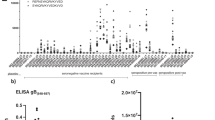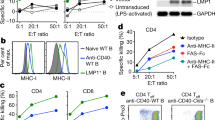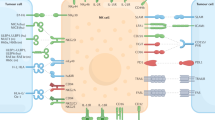Abstract
THE existence of cytolytic T lymphocytes (CTL) specific for antigenically related tumour cells during oncornavirus-induced oncogenesis in the primary host is well documented. They exist in murine sarcoma virus (MSV) tumour-bearing mice, during and after the tumour rejection1, and in Friend virus-infected mice, notably in the spleen of resistant C57BL/6 (ref. 2). It is probable that they play some role in tumour cell destruction in vivo3 and it can be supposed that the antigens of the tumour cell surface recognised by CTL are at least, for the most part, viral proteins or glycoproteins. It was suggested that CTL reacting with virus producer cells in non-oncogenic systems4, or with hapten-modified cells5,6 recognise an H–2-modified antigen. Therefore, it was of interest to determine whether the same situation exists in an oncornavirus tumour system. It is already known that anti-MSV CTL are much more efficient against syngeneic than against allogeneic tumour cells7,8, indicating that H–2 antigens may play some role in the CTL–target cell interaction. We report here that the H–2 specificities of the tumour cell surface determine the interaction with syngeneic anti-MSV CTL, the reacting antigen being either an H–2 specificity modified by the virus, or, less probably, a virus-induced antigen modified by an H–2 region product.
This is a preview of subscription content, access via your institution
Access options
Subscribe to this journal
Receive 51 print issues and online access
$199.00 per year
only $3.90 per issue
Buy this article
- Purchase on Springer Link
- Instant access to full article PDF
Prices may be subject to local taxes which are calculated during checkout
Similar content being viewed by others
References
Leclerc, J. C., Gomard, E., Plata, and Levy, J. P., Int. J. Cancer, 11, 426–432 (1973).
Leclerc, J. C., and Gomard, E., Proc. 66th Am. Ass. Cancer Res., 806 (1975).
Levy, J. P., and Leclerc, J. C., Adv. Cancer Res. (in the press).
Zinkernagel, R. M., and Doherty, P. C., J. exp. Med., 141, 1427–1436 (1975).
Shearer, G. M., Eur. J. Immun., 4, 507–533 (1974).
Forman, J., J. exp. Med., 142, 403–417 (1975).
Ortiz de Landazuri, M., and Herberman, R. B., Nature new Biol., 238, 18–19 (1972).
Senik, A., Gisselbrecht, S., and Levy, J. P., Int. J. Cancer, 16, 960–970 (1975).
Herberman, R. B., Nunn, M. E., Lavrin, D. M., and Asofsky, R., J. natn. Cancer Inst., 51, 1509–1512 (1973).
Bevan, M. J., Nature, 256, 419–421 (1975).
Koszinowski, U., and Ertl, M., Nature, 257, 596–597 (1975).
Gardner, I. D., Bowern, N. A., and Blanden, R. N., Eur. J. Immun., 5, 122–127 (1975).
Blank, K. J., Freedman, H. A., and Lilly, F., Nature, 260, 250–252 (1972).
Herberman, R. B., et al., J. natn. Cancer Inst., 53, 1103–1111 (1974).
Author information
Authors and Affiliations
Rights and permissions
About this article
Cite this article
GOMARD, E., DUPREZ, V., HENIN, Y. et al. H–2 region product as determinant in immune cytolysis of syngeneic tumour cells by anti-MSV T lymphocytes. Nature 260, 707–709 (1976). https://doi.org/10.1038/260707a0
Received:
Accepted:
Issue Date:
DOI: https://doi.org/10.1038/260707a0
This article is cited by
-
Expression and CTL recognition of cloned subgenomic fragments of moloney murine leukemia virus in murine cells
Survey of Immunologic Research (1985)
-
Resistance to cell-mediated cytotoxicity is correlated with reduction of H-2K gene products in AKR leukemia
Immunogenetics (1982)
-
Multiple cytolytic T-cell clones with distinct cross-reactivity patterns coexist in anti-self + hapten cell lines
Immunogenetics (1982)
-
Interspecies exchange of β 2-microglobulin and associated MHC and differentiation antigens
Immunogenetics (1981)
Comments
By submitting a comment you agree to abide by our Terms and Community Guidelines. If you find something abusive or that does not comply with our terms or guidelines please flag it as inappropriate.



